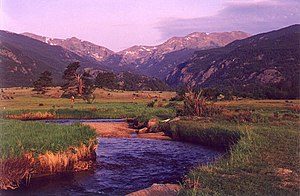Big Thompson River
| Big Thompson River | |
| River | |
|
The headwaters of the Big Thompson River are in Rocky Mountain National Park.
|
|
| Country | United States |
|---|---|
| State | Colorado |
| Tributaries | |
| - left | North Fork Big Thompson River |
| - right | Little Thompson River |
| City | Loveland |
| Source | Rocky Mountains |
| - elevation | 11,310 ft (3,447 m) |
| - coordinates | 40°25′41″N 105°47′29″W / 40.42806°N 105.79139°W |
| Mouth | South Platte River |
| - location | Near Greeley |
| - elevation | 4,670 ft (1,423 m) |
| - coordinates | 40°21′16″N 104°45′37″W / 40.35444°N 104.76028°WCoordinates: 40°21′16″N 104°45′37″W / 40.35444°N 104.76028°W |
| Length | 78 mi (126 km) |
| Discharge | for Loveland |
| - average | 72.5 cu ft/s (2.05 m3/s) |
| - max | 4,240 cu ft/s (120.06 m3/s) |
| - min | 0.48 cu ft/s (0.01 m3/s) |
The Big Thompson River is a tributary of the South Platte River, approximately 78 miles (123 km) long, in the U.S. state of Colorado.
The headwaters of the Big Thompson River begin in Forest Canyon within Rocky Mountain National Park in Larimer County, Colorado. The river flows east through Moraine Park to the town of Estes Park. There it is held in Lake Estes by the Olympus Dam before being released into the Big Thompson Canyon. The North Fork Big Thompson River also begins in Rocky Mountain National Park, on the northern slopes of the Mummy Range. This tributary flows east, through the town of Glen Haven, where it merges with the Big Thompson River in the town of Drake, in the Big Thompson Canyon.
From Lake Estes, the river descends 1/2 mile (800 m) in elevation through the mountains in the spectacular 25 mi (40 km) Big Thompson Canyon, emerging from the foothills west of Loveland. It flows eastward, south of Loveland across the plains into Weld County and joins the South Platte approximately 5 mi (8 km) south of Greeley. It receives the Little Thompson River approximately four mi (6 km) upstream from its mouth.
Water resources in the Big Thompson River are managed by the Northern Colorado Water Conservancy District as part of the Colorado-Big Thompson Project.
On July 31, 1976, during the celebration of Colorado's centennial, the Big Thompson Canyon was the site of a devastating flash flood that swept down the steep and narrow canyon, claiming the lives of 143 people, 5 of whom were never found. This flood was triggered by a nearly stationary thunderstorm near the upper section of the canyon that dumped 300 millimeters (12 inches) of rain in less than 4 hours (more than 3/4 of the average annual rainfall for the area). Little rain fell over the lower section of the canyon, where many of the victims were.
...
Wikipedia

